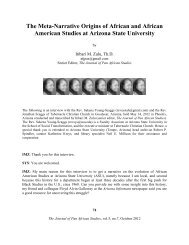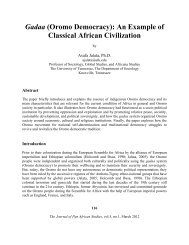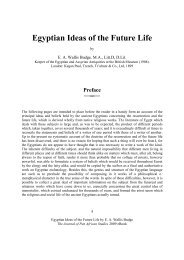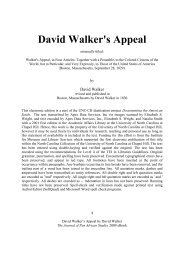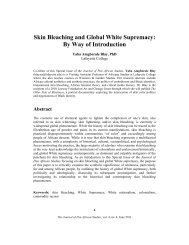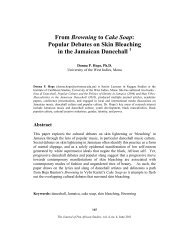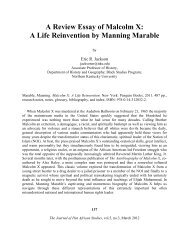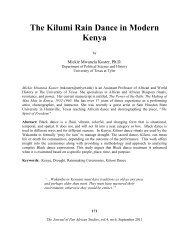Rhythms of the Gods: Music, Spirituality and Social Engagement in ...
Rhythms of the Gods: Music, Spirituality and Social Engagement in ...
Rhythms of the Gods: Music, Spirituality and Social Engagement in ...
Create successful ePaper yourself
Turn your PDF publications into a flip-book with our unique Google optimized e-Paper software.
Drumm<strong>in</strong>g for Òshun<br />
Drum performances for Òshun are also <strong>of</strong> two types: <strong>the</strong> drummed chant <strong>of</strong> ìyáàlù <strong>and</strong> <strong>the</strong><br />
ost<strong>in</strong>ato patterns <strong>of</strong> support<strong>in</strong>g drums, namely (<strong>in</strong> this example) kánran ìsáájú, kánran àtèlé,<br />
gudugudu <strong>and</strong> aguda. The gudugudu is particularly important because it is <strong>the</strong> one <strong>in</strong>strument<br />
that plays <strong>in</strong> full <strong>the</strong> rhythmic pattern that is associated with Òshun (see Figure 2). The two<br />
constituent phrases <strong>of</strong> gudugudu are also divided between kánran ìsáájú <strong>and</strong> kánran àtèlé as can<br />
be observed <strong>in</strong> Figure 2. The groove shown <strong>in</strong> Figure 2 constitutes what I would like to refer to<br />
as <strong>the</strong> sonic symbol <strong>of</strong> Òshun (because it is generally associated with <strong>the</strong> deity), <strong>and</strong> provides <strong>the</strong><br />
cyclic foundation for ìyáàlù, <strong>the</strong> <strong>in</strong>strument which plays <strong>the</strong> chants <strong>and</strong> songs that praise or<br />
supplicate <strong>the</strong> deity as illustrated <strong>in</strong> <strong>the</strong> excerpt below.<br />
Àasà Bán Sé (Help Me, Aasa)<br />
i. Àasà bán sé, àasà bán sé<br />
Help me, àasà (one <strong>of</strong> Òshun’s praise names)<br />
ii. Àasà bán sé, Òshun bán sé; pàmúrògòso<br />
Help me àasà; pàmúrògòso (ano<strong>the</strong>r praise name for Oshún)<br />
iii. Kí ní ńjó? Omi ní ńjó<br />
What is it that is danc<strong>in</strong>g? It is water that is danc<strong>in</strong>g<br />
iv. Kí ní ńbò? Omi ní ńbò<br />
What is it that is com<strong>in</strong>g? It is water that is com<strong>in</strong>g<br />
v. Ìyá ìjèshà, omi ní ńbò<br />
The mo<strong>the</strong>r from Ijesha; it is water that is com<strong>in</strong>g<br />
vi. Omi ìrorùn ni mo fi sìn<br />
Water <strong>of</strong> peace, goodness <strong>and</strong> comfort, we worship you<br />
vii. Omi ìrorùn la fi sìn<br />
Water <strong>of</strong> peace, goodness <strong>and</strong> comfort, we worship you<br />
viii. Omi ìrorùn la fi sìn<br />
Water <strong>of</strong> peace, goodness <strong>and</strong> comfort, I worship you<br />
ix. Ládékojú òshun Òshogbo<br />
Wealth that is complete, Òshun <strong>of</strong> Òshogbo<br />
x. Ìyá Ìjèshà, alómi lódù,<br />
The mo<strong>the</strong>r from Ìjèshà, big storage <strong>of</strong> water<br />
xi. Ògbudù gbadà agbadà gbarawó<br />
[Onomatopoeic epi<strong>the</strong>t phrases describ<strong>in</strong>g <strong>the</strong> movement <strong>and</strong> sounds <strong>of</strong> Òshun River]<br />
242<br />
The Journal <strong>of</strong> Pan African Studies, vol.3, no.9, June-July 2010



